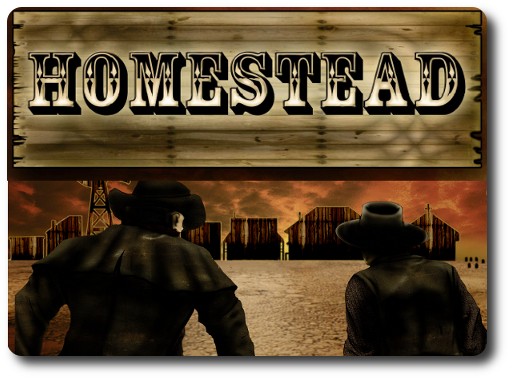
The Basics:
- For ages 8 and up (publisher suggests 12+)
- For 2 players
- Approximately 30 minutes to complete
Geek Skills:
- Active Listening & Communication
- Counting & Math
- Logical & Critical Decision Making
- Reading
- Pattern/Color Matching
- Strategy & Tactics
- Risk vs. Reward
- Hand/Resource Management
- Area Control
Learning Curve:
- Child – Moderate
- Adult – Easy
Theme & Narrative:
- Gather your friends and hire some extra muscle to protect a lonely prairie town or to take it over!
Endorsements:
- Gamer Geek approved!
- Parent Geek approved!
- Child Geek approved!
Overview
Many came out west to escape their problems and start fresh in a new and wild wilderness. But trouble always follows those who can be exploited. It didn’t take long for a small town in the dry prairie to be the target of a group of outlaws. Answering the call to defend the town, brave men and women step forward to put their lives on the line. But they are not alone. Others are willing to help…for a price.
Homestead, by Boundless Distraction, is comprised of 1 double-sided game sheet, 64 Unit tokens (32 white/32 black), 8 six-sided die (that show a number and an icon that represents the Units), 20 Coins, 16 Unit reference cards (8 per player), 8 Character cards.
Game Set Up
Note: before you play the game for the first time, you will need to place stickers on all the tokens and the dice. While not difficult, it can be time-consuming. Plan for at least a good 15 minutes to complete before you even think about playing the game.
To set up the game, first decide on which of the two maps you want to play on. On one side is a map named “Town Invasion”. This is the recommended map to use if you are playing with new players. The choices are limited and the game play is a little like a tug-of-war match that is easy to understand. The other side of the game sheet is the “Desert map”. This side of the game sheet has many more options for movement and forces the players to use much more strategy. Choose a side and place it, facing up, in the middle of the playing area between the two players. Note that for the duration of the overview, it is assumed the “Town Invasion” map was selected.
Second, give to each player a set of Unit cards (8 per player). These cards are placed in front of each player for quick reference and are visible at all times in the game. A description of each Unit is on the back of the cards.
Third, both players should now decide which character they are going to play as. While the Character cards do suggest “good guys” and “bad guys”, this is more for theme than anything else. Both players should select the character they want to play and not feel required to select characters that would naturally be opposed to each other. Optionally, both players could just randomly pick one character each from the Character card deck. Regardless of how the cards were selected, the Character card is placed on the table with the player’s Unit reference cards.
Fourth, both players now take all the Unit tokens of a single color (one player will have all the white and the other player will have all the black). The players can organize them if they like, but it is not necessary. What is necessary is both players finding the Character token. The game has two per player. One shows the image of a masked bandit and the other shows the Marshal’s star. The Character card will have an icon by the character’s name that identifies them as a law-breaker (masked bandit) or a law-keeper (Marshal’s star). And, again, it is perfectly OK for two law breakers to fight it out in the game and to have two opposing forces for “good” fight among themselves. Once the Character token is found, it is placed on opposite ends of the game sheet on the space closest to the player.
Fifth, each player should now find the die that matches their Character card. Each Character card shows a list of numbers. Each Character has their own odds of success and failure, which roughly translates into the Character’s ability to lead and take action. Players should match the number range on their Character cards to one of the six dice and put that die in front of them. The remaining dice are removed for the duration of the game.
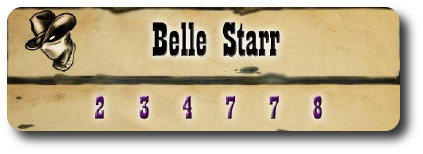
Sixth, each player gets 5 Coins, with the rest of the coins going in a pile and set off to one side of the playing area.

That’s it for game set up. Time to load your gun and get to work! Note that the game traditionally awards first-player to the masked bandit Character. If both players are playing the same faction (2 masked bandits, for example), then both players will need to decide who will go first.
Playing the Game
The game is played in rounds with each player taking a single turn per round. On a player’s turn, they will complete a series of sequential steps.
Step 1: Collect Coins
The first thing a player does on their turn is collect Coins. The number of Coins they collect is based on how much of the board the player controls. Every other space, starting with the player’s Character token and ending with the player’s furthest Unit token, awards the player with 1 Coin.
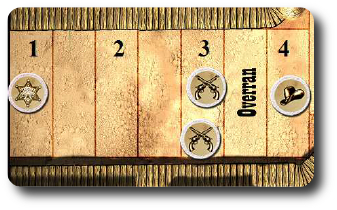
This player would collect 4 Coins
Money is not an abundant resource. All the money that is to be had is in the Coin pile. If there are no Coins left to take, the player is out of luck.
Step 2: Place Traveling Units
When Units are first purchased (in step 3), they are not placed on the game sheet right away. Instead, they are “in transit” or “travelling”. Traveling Units are now able to be activated and are placed on the space closest to the player’s Character on the game sheet. Only 3 Units can occupy a space on the game sheet, but they can be brought into the game either on the same space as the player’s Character unit, the space behind it, or the space in front of it. If no space is available, the Unit remains in transit.
Step 3: Purchase Units
The player can now spend their Coins to hire reinforcements. The players can buy as many Units per turn as they can afford or keep their Coins for later. Each Unit plays slightly differently and has unique strengths and weaknesses. In total, there are 8 different Units (Intel, War Wagon, Gun Slinger, Support, Scout, Demolition, Sniper, and Horses). The amount each Unit costs is listed in the Unit’s Stat-Bar on the Unit reference card. Coins are placed back in the pile and a token that matches the Unit icon is placed to one side of the board. This Unit is now considered “traveling” and cannot be placed until the player’s next turn during step 2. The one exception to this rule is the first round of play for both players, where they can buy and place a Unit in the same turn.
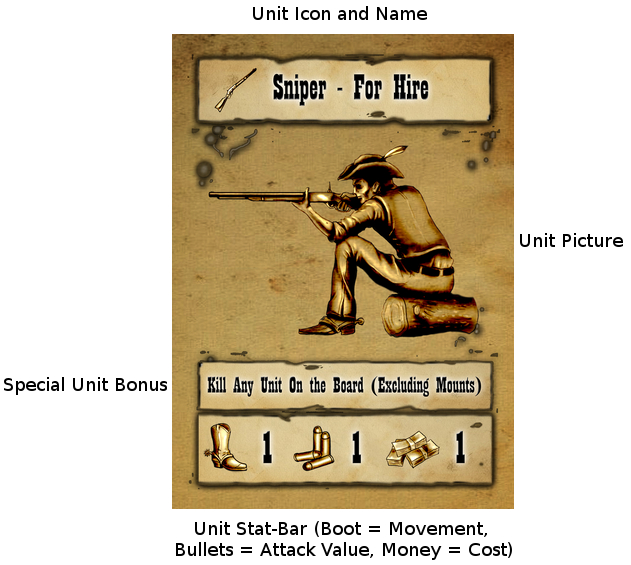
Note that the Horse and the War Wagon Units do not list bullets. Instead, they have a saddle icon. The number next to the saddle indicates how many Units the Horse or War Wagon can carry.
Step 4: Move Units
Units (and Characters) can move a number of spaces equal to their movement rate (as indicated on the reference cards with the Boot icon). Unit and Character movement is always forward or backwards (gaining ground or giving up ground). A player is never required to move any of their Units or Character, or even to use the maximum number of Movement. The only restriction is that players can only move up to 3 Units (including the Character) per turn. However, the Horse and War Wagon can carry other Units (up to its Unit capacity), but at least one Unit or Character must be on it before it can move. To mount or dismount a Unit takes 1 of the 3 possible moves.
Friendly Units can move through each other, but no space can ever contain more than 3 Units, but a player’s Units cannot travel through or stop in a space occupied by their opponent.
No player can move past the “Contested Line”.
Step 5: Take Action or Combat Roll
During this step, the player can activate all their Units on the “Contested Line” to attack their opponent. The “Contested Line” is the line that separates the spaces that the payers are both on and cannot advance past. A player is never required to activate any of their Units on the “Contested Line” if they don’t want to.
When combat occurs, all the Units on the “Contested Line” are in jeopardy of being removed. Both players use their die to determine the combat’s outcome and complete the following steps:
- Roll the die (simultaneously)
- Both players apply bonuses for their Units. A Unit is given a bonus when the die value also shows an icon that matches a Unit on the “Contested Line”. For example, Snipers can take out any Unit on the board (except for Horses, because that would be cruel). However, if both players roll the same icon, they cancel each other out.
- Each player adds up the attack strength of all the Units on the “Contested Line” (the number next to the Bullet icon on the Unit reference card) and adds the value rolled on the die.
- Totals are now compared. The player with the lower value looses all the Units on the “Contested Line”. Tie result in both players losing all their Units on the “Contested Line”.
- The player who wins the combat roll now advances all their Units on the “Contested Line” into the now free space.
Optionally, the player can elect to “Take Action” with their Sniper and Intel Units without putting them on the “Contested Line”. The player simply states they are attempting an action and points to what Unit they are rolling for. If the die result shows the icon of the Unit, the action succeeds and the Unit’s special unit bonus is triggered. If not, nothing happens and this step is now over.
Step 6: Use Remaining Moves
If the player did not move a total of 3 Units, they can now move any remaining Units or Character they like as long as the total number of Units moved during their turn is no more than 3.
Step 7: End of Turn
The player now announces that they are done and their turn is over. The next player now goes starting with step 1.
Winning the Standoff
The game can end one of two ways. The first is if one player is able to move one or more Units into their opponent’s’ “overran” spot on the game sheet. The second is if a player takes out their opponent’s Character token during combat on the “Contested Line”. Note that a Character token can never by taken out by a Sniper.
About the Dessert Map
The above overview addressed the game play using the “Town Invasion” map. If the “Dessert” map is used, game play is slightly different and more challenging.
- The number of Coins collected is equal to all the spaces between the player’s Character token and the furthest Unit.
- Traveling Units that are coming into play must be placed in a space adjacent to the Player token.
- Each space on the “Desert” map can only contain 1 Unit instead of 3.
- There are new movement restrictions with spaces on the “Dessert” map that do not allow movement through them.
- Snipers can no longer take out any other Unit on the game sheet as there are now objects in the map that block the Sniper’s line-of-sight.
- When attacking in combat, only 3 Units can be activated, but only if the two opposing Units are next to each other.
To learn more about Homestead and read the full rules, visit the game’s web page. You can also play the game for free on Vassal, an open-source virtual board game application.
Prediction
Oh, exciting! I think one of the most under used themes is the Old West. That time in American History is filled with interesting characters, extraordinary acts of courage, and the birth place of many legends and myths. And yet, we hardly ever see games using the Old West theme or narrative. But an interesting and exciting theme does not automatically a good game make. Just looking at the game based on the rules, it provides a good deal for the player to think about. Position, location, and resources are all important. In some ways, Homestead is like a miniature battle skirmish game.
For the Child Geeks, I don’t know how this is going to play out. There’s a lot for them to consider and I can see them getting confused. For the Parent Geeks, I think they’ll enjoy it because the game is pretty casual. Yes, there’s much to think about, but the weight of each choice is not terribly difficult. For the Gamer Geeks, I think they are really going to enjoy this one.
Teaching the game takes a bit. Not long, mind you, but do expect to take a good 10 or so minutes to explain the game in detail. I also highly suggest that you start with the “Town Invasion” side of the map, as this is perhaps the easiest map to teach to. You should also expect to take some time to explain and really make the case of how important it is to keep the “Contested Line” free and clear of any Unit the player doesn’t want to lose. Other than that, the rest of the game if pretty straight forward. Although you might find that teaching some aspects of the game is easier when the game is being played.
And so, after I explained the game to my oldest little geek and answered his questions, I reset the town for the big gun fight. As I did so, I asked him his thoughts on the game so far.
“Neat! I don’t remember playing a game like this before. Should be pretty cool.” ~ Liam (age 8)
Glad to hear he is optimistic and enthusiastic about the game! Let’s give it a couple of plays and see if it keeps his interest…and mine.
Final Word
The Child Geeks were a bit mixed on this game. For those who understood how the game was played, they had a wonderful time. Most of these Child Geeks were 8-years-old and older. Any Child Geek who became confused and started to get frustrated, ultimately ending in them leaving the table in a huff, were 7-years-old and younger. As such, we can easily suggest the game is playable with Child Geeks as young as 8, but your own individual results will differ. Game wise, however, the Child Geeks who played it all the way through loved it. The game plays fast, all the moves and decisions the player needs to consider make sense, and there is a great deal of control put in the player’s lap without feeling terribly difficulty or overwhelming.
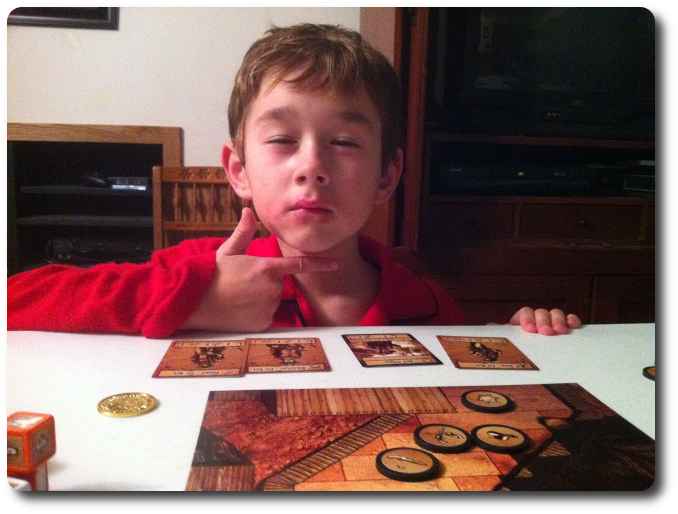
My little geek shows me his “gun” while I set up for an attack – INTIMIDATING!
Parent Geeks also had a great time with the game and were surprised how much fun it was. Even the non-gamer Parent Geeks enjoyed the game, commenting on how easy it was to understand the more complicated aspects of the game. In this case, the way the individual Units operated. This is actually an excellent point, as each Unit has a special ability that gives them a slight edge. How these are used is up to the player, but the game designer did a great job of explaining them, making it easy to understand. The Parent Geeks very much enjoyed the game and had a blast playing it with their peers and their family.
Gamer Geeks really liked this game, and considered it a well-designed and casual miniature skirmish experience. They liked how resources were gained, how much time and attention was put into the game balance, the multiple Units, and the two different maps. The Gamer Geeks also liked how small a role luck played in the outcome of battles and how a player, who took the time, could develop some interesting tactics and a winning strategy. Each Unit has its own strengths and weaknesses. Knowing how to leverage those was very important to victory. They were not a fan of the game sheet, however, and this made them exceedingly reluctant to give their approval. In the end, they decided the game play was good enough to overlook what they thought to be a bad choice in-game components.
I really like Homestead. It does a fantastic job of capturing the theme of the Old West and the game play is exciting. The game is also fast and the battles between the two players seems much more epic than what you would consider possible for a game that plays in less than 30 minutes. Perhaps the most surprising aspect of this game was the amount of depth it had. You really don’t get a good idea of how well designed this game is until you play it. After only a few games, you start to realize there is much to explore and think about on each turn. Games like Homestead, that have an easy learning curve and depth of play are always a joy.
Where the game really jumps from “good” to “great” is when you use the “Dessert” map. Tactical movement is a must as you slip snipers behind rocks to pick off the enemy one-by-one, and you must move your Units in a way that keeps them undercover while they move in for position. The game’s difficulty and depth greatly increase and each player is now forced to make the difficult choice of leaving some of their Units out in the open. A lot of thought goes into these battles, engaging the players on a much more intense level than the “Town Invasion” map.
If you are looking for an Old West game with gun fights of true grit, do take a look at Homestead. So far, it is easily the best Old West themed game I have ever played.
This game was given to Father Geek as a review copy. Father Geek was not paid, bribed, wined, dined, or threatened in vain hopes of influencing this review. Such is the statuesque and legendary integrity of Father Geek.




Pingback: Taking Criticism | Boundless Distraction